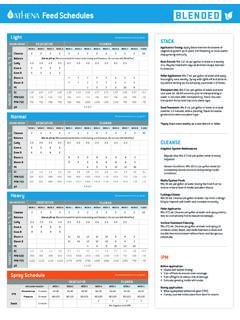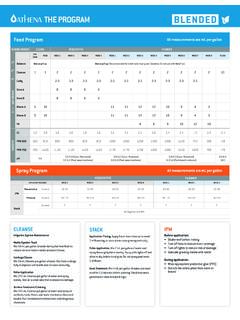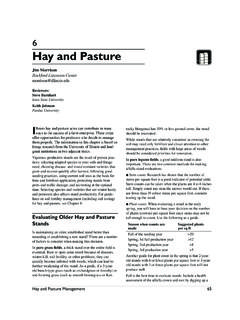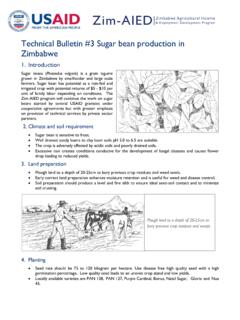Transcription of Planting and growing chestnut trees
1 Planting and growing chestnut trees The Pennsylvania Chapter of the American chestnut Foundation Planting and growing chestnut trees is a rewarding drained and somewhat acidic soil (pH ) on challenge. As with growing anything, there are gently sloping fertile land is best. Avoid heavy clay soils. Review your property's location on some tips and tricks to growing chestnut trees . The county soil maps from the Natural Resources goal of the Pennsylvania Chapter of the American Conservation Services (NRCS). Many of these chestnut Foundation (PA-TACF) is to restore the are available on-line (http://. American chestnut (Castanea dentata) to the forests ), but you may also find them in you local library. of the mid-Atlantic. To do this, we must plant a lot 2) Avoid Planting in swales. of trees ! To date, we have planted over 22,000 trees 3) Exposure. Full sun is best for growth, vigor and as part of our mission.
2 If you plan to join our efforts, seed production. A sheltered north-facing slope please take a few minutes to review the following protected from drying winds and low sun of win- ter may be better for cold windy sites. Planting information so that you might get the most out of on a slope may also help alleviate some drainage your chestnut Planting . We hope that by following issues. the recommendations contained within, that you will 4) Site preparation will depend on the condition of realize the growth potential necessary for timely in- the site. If the site is uncultivated, trees and brush should be removed, the field mowed, and re- oculation and nut production. growth controlled. Within Planting rows, spray Now that you've de- herbicide 2 weeks prior to Planting , or otherwise 1. Site selection cided to plant some remove sod and competing vegetation. 2. How many trees ?
3 5) Clearcuts vs. fields. Assuming you want maxi- 3. seed vs. seedling chestnuts, there are five mum growth and nut production, you will be 4. Spacing major decisions that choosing an open site. Clearcuts typically have 5. Maintenance you will be facing. proper mycorrhizal associations for trees and may maximize growth potential because of their SITE SELECTION fertility. Old fields can often be easier to main- tain, but they often have hardier weeds that take persistence in management. An open field can be an ideal place to start your 6) How many trees ? A final consideration that will chestnut trees . Be sure to need to be made is how many trees you'll want to manage the sod plant. This can determine the size of the area on recently clearcut area can which you'll be starting your orchard. Of course, also be a fine place to start the opposite could be true, so our next question is an orchard.
4 The soils are often fertile and the site will have less weed competition than a field. HOW MANY trees ? The next question you'll need to answer is how The first decision that many trees you're going to want. This really de- you are going to need to pends on several factors. What type of trees you'll make when Planting be Planting , how long you want to have them on chestnuts is WHERE to your land, and the amount of land you have avail- plant your chestnuts. able, which could be the most important limiting fac- Typically, chestnuts are a hardy species, but they do tor. have some general requirements. Remember that you will need to plant at least 2. 1) Well-drained, acidic soil type. This is *the*. chestnuts to get nut production. Account for some most important consideration when Planting chestnuts. Choose wisely. Sandy, loamy, well mortality over the years, and plant at least 5.
5 If you 2 PA-TACF Planting Manual, 2006v just want to plant a few trees , a good amount would American, Chinese, Japanese, European, and hy- be between 10 to 50. brids chestnuts, as available. 3. The MSR/CMS and American germplasm re- For the purposes of establishing a Planting of chest- serve orchard. In 2001, PA-TACF began a pro- gram that aims to increase the Chapter's inclu- nuts for PA-TACF, we typically ask for a plot of sion of diversity of resistance sources while, at land larger than acres, but no more than 3 acres. the same time, incorporating a method to ease the An individual grower usually cannot take on more difficulties of controlled pollination. MSR. than 900 trees of any backcross generation** (Multiple Sources of Resistance) and CMS. (Cytoplasmic Male Sterility) are covered else- Once you have established how much land is avail- where, but, briefly, the inclusion of these meth- ods are merely offshoots of the standard back- able, the type of trees you will plant will be deter- cross orchard most often established as part of mined after consultation with your Chapter's breed- TACF's efforts.
6 Some additional record keeping ing coordinator. All growers should start by testing is required. To date, a minimum of 40-80 trees their growing methods and land by Planting open planted is necessary. As later generations are bred, this number will increase. This orchard pollinated American chestnuts, which are available types is a great way for the new grower to be- each year from the Chapter. come involved with our breeding program. 4. The Backcross Orchard is not for the faint of Depending on the year's supply, the Chapter will heart. Most often, a minimum of 350 trees is re- have needs for different orchard types. Currently, quired. The amount of labor and input required the Chapter promotes the following types of or- can be high, and we often require fencing of a site to protect from deer. Advanced backcross chards, which, to date, increase in complexity from 1.
7 seed are difficult to make (see our section on Pol- to 4. The theory behind the breeding and establish- lination), so we want to be assured of receiving ment of these orchards have been covered exten- the most from those efforts. With very few ex- sively in the TACF Journal; however, the following ceptions, we will not plant more than 900 trees with any one grower because of the amount of briefly covers what is involved in each type. input required. 1. The Backyard Breeder. This type has a grower establish a couple of American chestnuts near a We generally ask that growers who want to establish couple of Chinese or hybrid chestnuts. Although an orchard work closely with our breeding coordina- 5-10 trees will be planted, no more than 4 should tor to identify the orchard that will best fit their be kept. When the time comes, and with more needs, as well as the needs of the Chapter.
8 In Penn- than 2 trees , the excess trees will need to be emasculated, the catkins removed, to facilitate sylvania and New Jersey, we ask that you contact our collection of proper seed type. The trees should Leffel Research Center at Penn State University, the be given ample room. Plant on 20' centers. contact information for which may be found at the 2. Demonstration and education orchards. These back of this document. are a great way to get your organization involved. These orchards typically take very little land, of- fer a great opportunity for learning the differ- ences in chestnut species, and also offer a great DIRECT SEEDING VS. visual representation of how breeding works. Planting SEEDLINGS. Planting usually involves 5-10 trees each of: Once you get your seed , the next decision that will **For later generations, such as the B3F2 or higher genera- need to be made is whether to plant seeds or to plant tion, different rules apply.
9 A single individual grower can po- tentially grow thousands. But, we hope that you might practice seedlings. Before Planting , be sure to keep your seed on a few using these methods before you plant large amounts of in cold storage (a refrigerator) away from apples and highly advanced material. PA-TACF Planting Manual, 2006v 3. pears until you are ready to plant. The colder the storage, but above freezing, the longer the seed will keep. Typically, Planting seeds is easier and less labor in- tensive than Planting seedlings. Germination of pure chestnut species, as well as advanced hybrids, is often very high, often eclipsing 90%. For early hybrid generations, F1 and BC1 generations espe- cially, incompatibilities occur that often decrease germination significantly. When Planting those gen- When Planting chestnuts indoors, be sure to use pots that are erations, it may make more sense to test germination deep enough.
10 Be sure to label the pots well. in the greenhouse and outplant using seedlings. **Before Planting ** be certain to read the section on with this mixture so that it is wet, but not soaking wet. maintenance and make the decisions on how to prop- 5) Don't plant the seed too deep. Make a Planting erly maintain your chestnut orchard well into the fu- hole about 3-6 inches deep. Backfill the hole ture. with the Planting mixture. About 1/2 to 1 inch from the surface, place the chestnut , and then cover with the mixture. When placing the chest- DIRECT SEEDING CHESTNUTS nut in the backfill, make a hole with your finder in the dirt to allow for placement of the radical. If you have decided to direct seed chestnuts, there 6) Make a good home. Make a hole using a bulb are a few things to keep in mind. planter, auger, shovel, or what you have avail- able. 1) Plant early in the spring.







